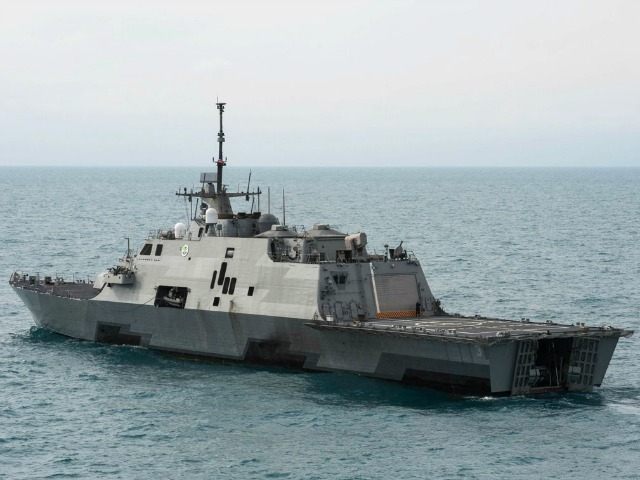The USS Fort Worth, prior to breaking down in Singapore earlier this month, had been deemed vulnerable by the Pentagon after being subjected to simulated effects of equipment shutdowns and battle damage.
In December, the USS Milwaukee also became disabled, days after it was commissioned on (Nov. 21). Both U.S. Pacific Fleet vessels are littoral combat ships (LCS), the newest class of warship in the U.S. Navy fleet.
The Milwaukee (LCS 5) is about 3 years younger than its nearly five-year-old sister ship, Fort Worth (LCS 3).
“Troubles for the ships, which cost around $360 million apiece, began in December, when the USS Milwaukee (LCS 5), broke down off the East Coast and had to be towed 40 miles to a naval base in Virginia,” reports CNN. “The 388-foot-long, 3,400-ton Milwaukee was on its way to its home port of San Diego after commissioning in November.”
“The Milwaukee became disabled in the Atlantic when metallic debris was found in filter systems in the ship, causing a loss of pressure in lubricant to gears that transfer power from the ship’s diesel and gas turbine engines to its water jet propulsion system,” it adds.
CNN quotes Navy spokeswoman Lt. Rebecca Haggard as saying the cause of the Milwaukee’s problems have yet to be determined.
Meanwhile, the Fort Worth is currently idled due to what the U.S. Pacific Fleet described as “a casualty to the ship’s combining gears during an in-port period in Singapore, Jan. 12.”
“Based on initial indications, the casualty occurred due to an apparent failure to follow procedures during an operational test of the port and starboard main propulsion diesel engines (MPDEs),” explained the Hawaii-based fleet in a press release. “An investigation is underway to examine the incident in depth and determine any necessary corrective action.”
“A team of technical specialists is currently on board Fort Worth to evaluate the gears and required repairs,” it adds. “There is no estimated date of completion at this time.”
Fort Worth left her homeport of San Diego over a year ago, in November 2014. It has been navigating the South China Sea since.
The ship was deployed even after computer simulated tests by the Pentagon revealed that the vessel was vulnerable to a potential enemy attack weeks prior to its deployment.
Bloomberg News learned from Michael Gilmore, the Pentagon’s director of combat testing, that a “total ship survivability test” of the Fort Worth conducted in October of last year “highlighted the existence of significant vulnerabilities” in the design of the littoral combat ship.
Lockheed Martin Corp. designed and constructed the U.S. Navy’s LCS class ships. The vessels were designed to operate in littoral environments — in shallower water close to the coast.
“Much of the ship’s mission capability was lost because of damage caused” by the simulated effects of a fire preceded by a hypothetical weapons attack, Gilmore said in the unclassified assessment prepared for Congress and obtained by Bloomberg News.
During the at-sea testing, “the crew is… subjected to the effects of equipment shutdowns and battle damage,” noted the news outlet.
It appears that an equipment malfunction forced the Fort Worth, which was on a 16-month deployment to Asia that began in November, to dock in Singapore.
The Navy spokeswoman told Bloomberg News that the test on the Fort Worth was effective in identifying potential problems.
Kent said the simulated assessment “was a successful event that allowed the Navy to demonstrate that the inherent ship design features and applied LCS tactics, techniques and procedures provided the crew with the ability to contain damage, restore capability and care for personal casualties given the expected damage.”
After the test, the Navy was able to identify “potential system, equipment and procedural improvements which could further enhance ship and crew survivability,” she added.
Lt. Cmdr. Matt Knight, a Navy spokesman, said that prior to the recent incident, the Fort Worth had been a “model of reliability” while deployed over the past year.
Although the Fort Worth has never been in combat, it did encounter a Chinese vessel in disputed waters of the South China Sea last May.
The U.S. and China are at odds over a territorial dispute in the South China Sea.
CNN acknowledges that “even without all the facts, Navy officials said that evidence does not suggest a link between the two incidents that would reflect a systemic issue in the LCS program.”
U.S. Secretary of Defense Ash Carter has ordered the Navy to reduce its estimated fleet of the ships, from 52 to 40, “saying resources that would have been devoted to the 12 proposed LCSs would be better expended on Navy ships with better firepower, as well as submarines and aircraft.”
The Navy’s top uniformed officers have expressed disapproval of Carter’s plan, offering support for the LCS ships.
“Despite experiencing two incidents in as many months, [Lt. Cmdr. Tim] Hawkins, [a Navy spokesman] said, the Navy’s long-term strategic plan for using littoral combat ships has not changed,” it adds.

COMMENTS
Please let us know if you're having issues with commenting.